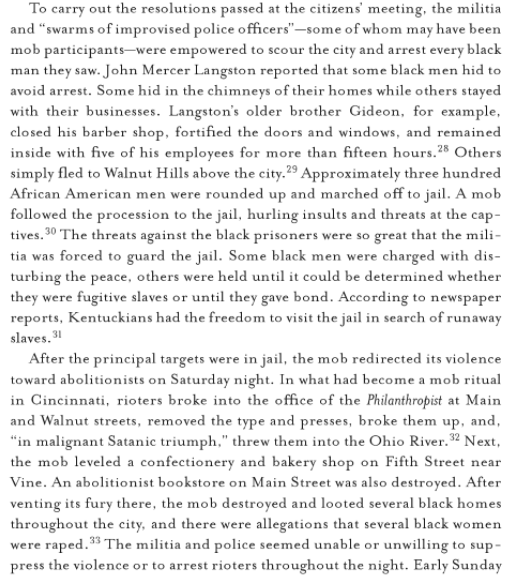Taylor provides account of Cincinnati race riot of 1841, when Able lived there.
- Type
- Book
- Source
- Nikki Marie Taylor Non-LDS
- Hearsay
- DirectSecondary
- Reference
Nikki Marie Taylor, Frontiers of Freedom: Cincinnati's Black Community, 1802-1868 (Athens, OH: Ohio University Press, 2005, 123
- Scribe/Publisher
- Ohio University Press, Gideon Langston
- People
- Nikki Marie Taylor, John Mercer Langston, Gideon Langston
- Audience
- Reading Public
- Transcription
To carry out the resolutions at the citizens' meeting, the militia and 'swarms of improvised police officers'—some of whom may have been mob participants—were empowered to scour the city and arrest every black man they saw. John Mercer Langston reported that some black men hid to avoid arrest. Some hid in the chimneys of their homes while others stayed with their businesses. Langston's older brother Gideon, for example, closed his barber shop, fortified the doors and windows, and remained inside with five of his employees for more than fifteen hours. Others simply fled to Walnut Hills above the city. Approximately three hundred African American men were rounded up and marched off to jail. A mob followed the procession to the jail, hurling insults and threats at the captives. The threats against the black prisoners were so great that the militia was forced to guard the jail. Some black men were charged with disturbing the peace, others were held until it could be determined whether they were fugitive slaves or until they gave bond. According to newspaper reports, Kentuckians had the freedom to visit the jail in search of runaway slaves. After the principal targets were in jail, the mob redirected its violence toward abolitionists on Saturday night. In what had become a mob ritual in Cincinnati, rioters broke into the office of the Philanthropist at Main and Walnut streets, removed the type and presses, broke them up, and 'in malignant Satanic triumph,' threw them in the Ohio River. Next the mob leveled a confectionary and bakery shop on Fifth Street near Vine. An abolitionist bookstore on Main Street was also destroyed. After venting its fury there, the mob destroyed and looted several black homes throughout the city, and there were allegations that several black women were raped. The militia and police seemed unable or unwilling to suppress the violence or to arrest rioters throughout the night.
- Citations in Mormonr Qnas
The B. H. Roberts Foundation is not owned by, operated by, or affiliated with the Church of Jesus Christ of Latter-day Saints.

